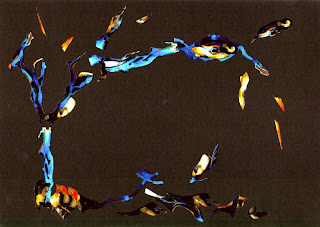Jim raised an issue about realism a while back, which is something I think about a lot, and Matisse's phrase 'exactitude is not truth' seems to have planted itself in my mind. What Matisse said is this:
Among these drawings, which I have chosen with the greatest of care for this exhibition, there are four - portraits perhaps - done from my face as seen in a mirror. I should parrticularly like to draw these to the visitor's attention.
These drawings seem to sum up observations that I have been making for many years on the characteristics of a drawing, characteristics that do not depend on the exact copying of natural forms, nor on the patient assembling of exact details, but on the profound feeling of the artist before the objects which he has chosen, on which his attention has focussed, and the spirit of which he has penetrated.
My convictions on these matters crystallised after I had verified the fact that, for example, in the leaves of a tree - a fig tree, particularly - the great difference of form that exists among them does not keep them from being united by common quality...
Thus there is an inherent truth which must be disengaged from the outward appearance of the object to be represented. This is the only truth that matters.
I struggle with the idea of truth, anywhere, and yet a philosopher friend of mine also has me almost convinced that, actually, and perhaps especially after postmodernism, something called truth matters a great deal. I don't like it as it's being used here, because it seems to suggest that things have an essence, one that's waiting to be 'discovered', or, in this case, perceived by the artist. This passage also makes me think of Plato's forms, which of course I don't understand, but I retain an uncomfortable impression of an argument for the existence of something Real-which-we-cannot-see; which in turn makes me think of all the Hindu and Buddhist arguments for a Real behind appearances. Those based in Hindu and Buddhist traditions tend to say that those schooled in Anglophone traditions can't begin to get what this means (for example, the translation of the Sanskrit term maya as illusion is arguably a red herring for an Anglophone mind...).
But Matisse is trying to say something important about drawing, and all those obsessions about 'getting a likeness' etc.
The four drawings in question are of the same subject, yet the calligraphy of each one of them shows a seeming liberty of line, of contour, and of volume expressed. Indeed, no one of these drawings can be superimposed on another, for all have completely different outlines..... Nevertheless, the different elements which go to make up these four drawings give in the same measure the organic makeup of the subject. These elements, if they are not always indicated in the same way, are still always wedded in each drawing with the same feeling - the way in which the nose is rooted in the face - the ear screwed into the skull - the lower jaw hung....even though the shade of expression varies in each one.
It is quite clear that this sum total of elements describes the same man, as to his character and his personality, his way of looking at things and his reactions to life, and as to the reserve with which he faces it and which keeps him from uncontrolled surrender to it.
It is thus evident that the anatomical, organic inexactitude in these drawings, has not harmed the expression of the intimate character and inherent truth of the personality, but on the contrary has helped to clarify it.
...Each of these drawings, as I see it, has its own individual invention which comes from the artist's penetration of his subject, going so far that he identifies himself with it, so that its essential truth makes the drawing. It is not changed by the different conditions under which the drawing is made; on the contrary, the expression of this truth by the elasticity of its line and by its freedom lends itself to the demands of the composition; it takes on light and shade and even life, byt the turn of the spirit of the artist whose expression it is.
L'exactitude n'est pas la verite.
Do we buy this? I can't decide. I do agree that the line doesn't have to accurately represent the three dimensional object. However, if the artist is going to draw a figurative element that calls to mind something that can be seen in the visual world, and that is likely to be familiar to the viewer, then it seems to me that the line has to be convincing in some way. Convincing doesn't mean accurate to nature. But it means that the mind of the viewer accepts the image, however distorted, rather than tries to reject it (which I have to say my mind does with quite a bit of Matisse's work...).
Perhaps Klee said something a bit more subtle:
Art does not reproduce the visible; rather, it makes visible.
This seems to leave space for exactitude or not - what matters isn't how accurate, but perhaps whether the drawing brings an object to attention; arresting the tendency of normal vision to sweep past something miraculous that it doesn't bother to stop to see??
All quotes from Chipp, 1968, Theories of Modern Art UCP














